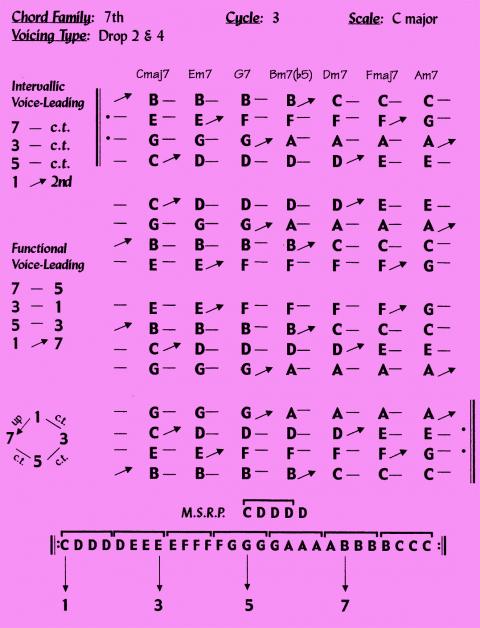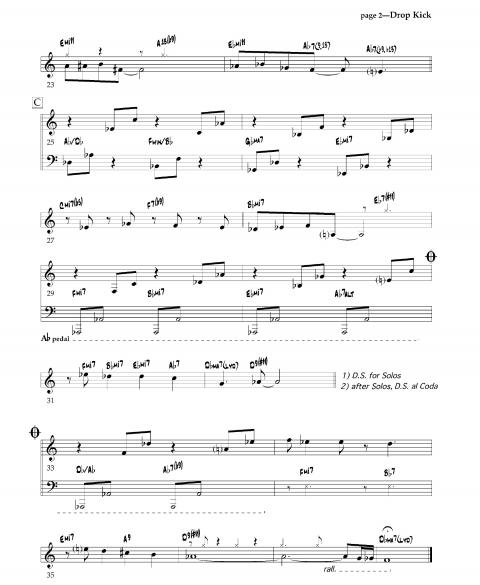There Are No Shortcuts

Mitch Haupers
As the managing partner of a small online publishing venture (www.mrgoodchord.com) with guitar guru Mick Goodrick, I am often asked by readers and students for ways to bring our materials more directly into their playing and writing. Some students are interested only in the best way or the fastest results. My response to this kind of thinking is always the same: there are no shortcuts. Patience and long periods of study and absorption are required. A variation on a cliché comes to mind: “Good chords come to those who wait.”
Mr. Goodchord’s Almanac of Guitar Voice-Leading, Volumes 1–3 represent a vast harmonic resource and reference guide for any musician, composer, or arranger who is willing to put in the time. Admittedly, the novelty of the design and layout may seem unwieldy at first (see example 1), but some exploration of the logic and philosophy behind it should yield worthwhile results.
The first two volumes contain every three- and four-part chord possible in the keys of C major, C melodic minor, and C harmonic minor. All the work of figuring them out and organizing them has been done. You just need to start playing with the material. There is one caveat: there’s no system of pedagogy or instruction involved. There are no page numbers, and there is no recommended order for studying the material.
Self-discovery is an integral part of meaningful learning, so enjoy the process. If you work with this material for a while, you inevitably discover that your mistakes lead to the most interesting musical outcomes. Prepare yourself to recognize these important moments, and to take advantage of them when they arise.
The Order of Things
While working with these materials last summer, I played alternating-constant-structure seventh chords in drop 2 and 4 voicings (see example 2). I stumbled on a way to create the illusion that chords, with roots moving in thirds and sixths (cycles 3 and 6), seemed to have more motion than they actually do (see examples 3A to 3C).
After moving through the full chromatic cycle as an exercise, I limited movement to only four major key centers with these eight chords: Db and Fm, Ab and Cm, Eb and Gm, Bb and Dm. At that point, I decided that the progression needed to move away from constant structures, so I experimented with how and when to break the pattern. Since the chord qualities I used alternated between major and minor, the logical place to escape was on the min7 chord, which I treated as a IImin7 to modulate to a new key (see example 4).
The progression still seemed too long, so I cut it in half using the Cmin7 as the pivot chord for a modulation to Bb. But I made the mistake of playing an Ebmin7 after Cmin7, which led me to cadence back in Db. This cyclic idea appealed to me. Next, I began working with other chord types (see example 5). I also tried playing the progression while staying diatonic to the key of Db major. I didn’t like the sound of the progression Dbmaj7, Fm7, Ab7, Cmin7b5 because the dominant chord was followed by the leading tone chord. So I returned to the original, which cadences back into Db.
It’s worth mentioning that after some years of working with these voice-leading materials, my entire sense of musical architecture has been affected. I see new patterns and relationships and more readily recognize their integral importance throughout a composition. This skill isn’t something I tried to learn.
Naturally, I began to look for new ways to incorporate the idea of thirds throughout the exercise beyond simply using the root motion of cycles 3 and 6. Among the patterns I explored were key centers separated by thirds and melodic fragments that used intervals of thirds. Soon a tune formed, and the idea of a three-part, 24-bar form evolved. To further shape the piece, it was time to open myself to inspiration.
Easier Done Than Said
For me, this is where the process gets a bit mysterious. My father played the piano and loved jazz, so I grew up hearing a lot of Bill Evans, Art Tatum, Oscar Peterson, Bud Powell, and others. One of the earliest bop tunes I recall hearing was “Bouncin’ with Bud.”
Some time ago, I rediscovered this Bud Powell tune and enjoyed figuring out the voicings on the break section. For me, the subtle difference between the voice-led sound of the diminished chord, or inverted secondary dominant, and the more typical circle of fifths root motion in the cadences from D7 to Gm and G7 to Cm is quintessential Bud Powell.
I also started thinking about Chick Corea’s tune “Bud Powell.” Corea’s signature is evident in the Latin section of the extended bridge, where a Phrygian-sounding pedal creates a momentary suspension of the more typical bebop harmonic language preceding and following it, forming an 18-bar bridge.
In Corea’s tune, I noted that rather than adhere to typical 32-bar AABA form, he allows his musical ideas to flow in a more organic fashion. The result is a six-measure pedal section that offers a respite between the tricky bop melody line and fast-moving changes on either side of it.
After revisiting these tunes, I decided to try writing a Bud Powell–style tune. I called it “Drop Kick” (example 8). I dedicated it Berklee Piano Department Assistant Chair Tony Germain, a longtime friend and mentor. In the tune, I incorporated my ideas with constant structures and drop 2 and 4 voicings.
Let’s look at the second and third occurrences of the drop 2 and 4 voicings and the chord symbols used in these sections. In measure 5 of the A section (see example 6), the chord symbols may seem cumbersome, but I included them as a reminder to myself to play those specific voicings. The melody notes also outline these changes, but I left the symbols in the chart, hoping to elicit future ideas for arranging and improvising. On the top staff, simplified chord symbols for soloing are notated.
In measure 17 of the last A section (see example 7), the third occurrence of drop 2 and 4 voicings reverses the root motion by using cycle 6. With the use of two hybrid chords (called triad-over-bass note, or TBN I and II chords, in the voice-leading books), I added a bit of nuance and color. These can also be viewed as incomplete seventh chords because of the missing third.
This lesson is an effort to share some of the processes involved in the long-term absorption of materials and the influence they exert on your composition and improvisation. For those who feel overwhelmed by the amount of work involved to learn this material, realize that you have the rest of your life to explore, refine, and liberate your music from the confines of your head and heart. Enjoy the self-teaching process, and get started now!
Mitch Haupers is an Associate Professor of Core Curriculum and Performance Studies. He and Professor Mick Goodrick will present summer workshops on the Mr Goodchord materials with emphasis on voice-leading, rhythm, composition, and improvisation. Visit www.mrgoodchord.com for details.

Example 1, Mr. Goodchord's Voice-Leading Chart



Drop Kick Pg. 1

Drop Kick Pg. 2




